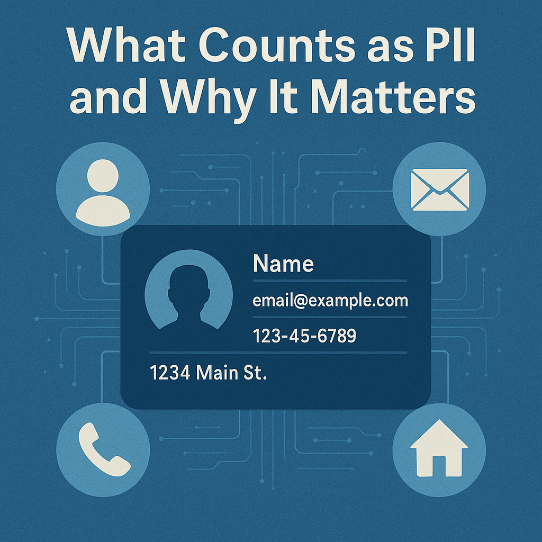The New Frontier of Personal Security
The line between our digital and physical lives has all but disappeared. Family photos, banking details, medical histories, and even home addresses live online, often in more places than we realize. This vast digital footprint can be both convenient and dangerous: once personal data leaks into the public sphere, it’s nearly impossible to pull it back.
Today, digital identity protection has become as vital as securing your home or purchasing health insurance. From social media oversharing to corporate data breaches, the threat to personal information touches every household. Yet most families still underestimate how exposed they are or how easily their information can be exploited by advertisers, scammers, or even artificial intelligence systems harvesting data at scale.
This article provides a comprehensive overview of digital identity protection and Personally Identifiable Information (PII) removal. It serves as a roadmap to understanding what PII is, how it spreads, how to clean it up, and how to protect both your privacy and peace of mind. Each section introduces a key theme with practical insights and links to an in-depth guide for readers who want to go further.
If you’re new to the topic, start with our Beginner’s Guide to PII, which explains what counts as personal data and why it’s so valuable to protect.
1. What Counts as PII and Why It Matters

Before you can protect your digital identity, you must understand what makes it identifiable. Personally Identifiable Information , or PII, refers to any data that can directly or indirectly reveal who you are. This includes obvious details such as your full name, Social Security number, and home address, but also subtler identifiers: IP addresses, geolocation tags, voice recordings, and even browsing patterns
PII matters because it forms the foundation of your digital self. Every online form you fill out, loyalty program you join, or smartphone app you install contributes pieces to a mosaic of identity that can be reassembled by others. Cybercriminals exploit this data to commit fraud or identity theft, while legitimate companies use it for targeted marketing and profiling.
The more PII you scatter across the internet, the easier it becomes for others to impersonate you or track your behavior. Understanding what counts as PII is the first step toward taking control of it.
Read the companion article: What Is PII and Why Does It Matter? (Beginner’s Guide), which breaks down types of PII, real-world examples, and privacy implications in detail.
2. How Your Information Gets Exposed Online
Even the most cautious users leave digital trails. Personal information can leak through surprising channels, some voluntary, others completely beyond your control. Every public post, online purchase, and smartphone app adds to a growing profile about you. Meanwhile, companies that store your information may suffer data breaches, exposing millions of records to the dark web in seconds.
Other exposure points include public databases, such as voter rolls and property records, social media oversharing, unsecured Wi-Fi connections, and digital trackers that follow your browsing behavior. Seemingly harmless actions, like entering a giveaway or signing up for a “free” service, often involve trading personal data for convenience.

Once exposed, this information can be scraped, copied, and sold endlessly between data brokers. Understanding how exposure happens allows you to plug the leaks before they spread.
For deeper insight, see: 7 Ways Your Personal Information Gets Exposed Online.
3. Removing Data from Brokers and Public Sites

Knowing your data is exposed is one thing, getting it removed is another. Hundreds of data broker websites aggregate names, addresses, and contact information, packaging and reselling them for marketing, background checks, or identity verification services. These sites rarely request your consent and often re-list your data even after removal
Fortunately, you can fight back. Many brokers are legally required to honor opt-out requests, though the process can be tedious. You’ll need to identify which brokers list you, follow their specific removal procedures, and verify deletions periodically. Automated PII-removal services can simplify the process but often require ongoing subscriptions to monitor new exposures.
While complete erasure is nearly impossible, consistent cleanup dramatically reduces your digital footprint and limits data misuse. The key is persistence and knowing where to focus your efforts.
Learn more in: How to Remove Personal Information from Data Broker Website, which provides detailed removal checklists, sample emails, and a comparison of professional services.
4. Preventing Identity Theft and Protecting Your Family
Once your personal information circulates online, the risk of identity theft increases, sometimes exponentially. Criminals can open credit accounts, file false tax returns, or impersonate you for financial gain. Protecting against these threats requires proactive, family-wide habits rather than one-time fixes.
Start with digital hygiene: use strong, unique passwords stored in a password manager; enable two-factor authentication wherever possible; and teach family members to recognize phishing attempts. Monitor credit reports and use identity-protection services that alert you to unusual activity. For children and elderly relatives, set up parental controls or credit freezes to prevent unauthorized access.

Equally important is cultivating awareness. Discuss online privacy as openly as you would household safety. Family members who understand why it matters are far less likely to fall victim to scams or leaks.
Read next: Protecting Your Family from Identity Theft: Best Practices, featuring real-world case studies, security checklists, and expert recommendations.
5. Managing Digital Identity After Death

When a loved one passes away, their online identity often lingers, social media profiles, email accounts, cloud storage, and digital subscriptions remain active, sometimes indefinitely. Without proper planning, these accounts can become targets for fraud or emotional distress for surviving family members
Managing one’s “digital legacy” means organizing login credentials, specifying what should happen to each account, and granting trusted individuals access when needed. Many major platforms now offer legacy contact or memorialization options, but families rarely activate them. Including digital assets in estate planning ensures smoother transitions and protects against posthumous identity theft.
Digital legacy management isn’t only about closure, it’s about preserving dignity, privacy, and family control. Planning today spares your loved ones confusion tomorrow.
Explore this topic in depth: Digital Legacy: Managing Online Accounts After Death, which includes platform-specific instructions, legal considerations, and secure password-vault strategies
6. The Psychology of Digital Peace of Mind
Protecting your digital identity isn’t just a technical task, it’s a psychological one. Many people experience a low-grade anxiety about being watched, hacked, or impersonated online. Studies show that individuals who take steps to secure their data report higher levels of confidence and lower stress overall.

When families organize their personal information, establish clear routines, and use digital-security tools effectively, they create a sense of control that extends beyond the screen. That peace of mind can improve focus, relationships, and even sleep quality. The knowledge that you’ve reduced risk, especially for children or elderly relatives, translates into genuine emotional relief.
Digital safety, in other words, supports mental well-being. Protecting your data protects your calm.
Read more in: The Psychology of Peace of Mind, which explores behavioral research, expert perspectives, and methods to reduce digital-security stress.
Taking Control of Your Family’s Digital Footprint
Digital identity protection is no longer optional, it’s a core part of family preparedness. Every online action contributes to a personal data ecosystem that either empowers or endangers you. Understanding what information exists, where it resides, and how to control its use allows families to act, not react.
Begin with awareness: learn what PII you share, monitor where it appears, and commit to periodic cleanups. Then build habits, strong passwords, security updates, and open communication, that make privacy a family value.
Peace of mind comes not from eliminating all risk, but from knowing you’ve taken the right steps to manage it. In the digital age, that confidence is priceless, and essential.


